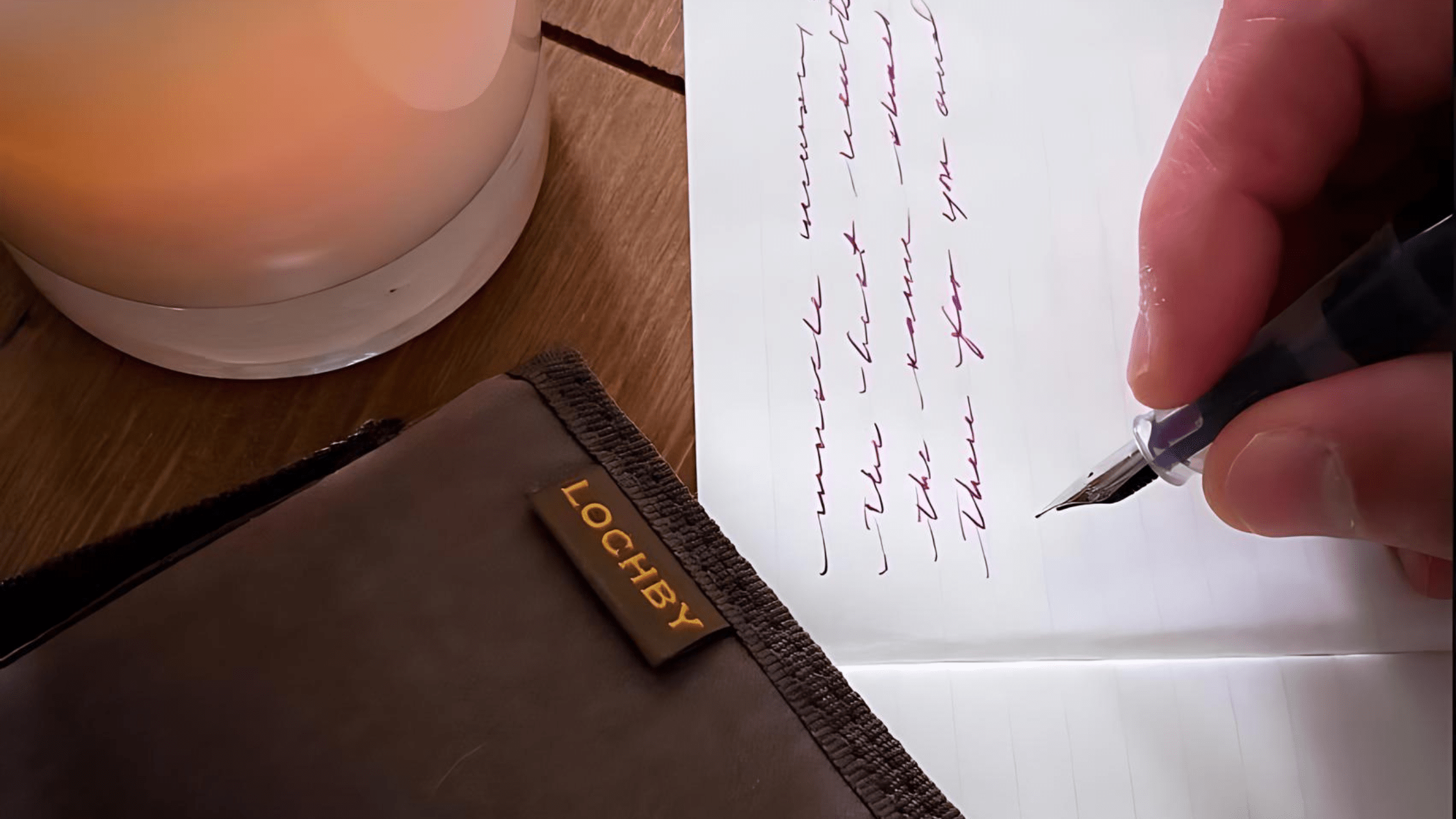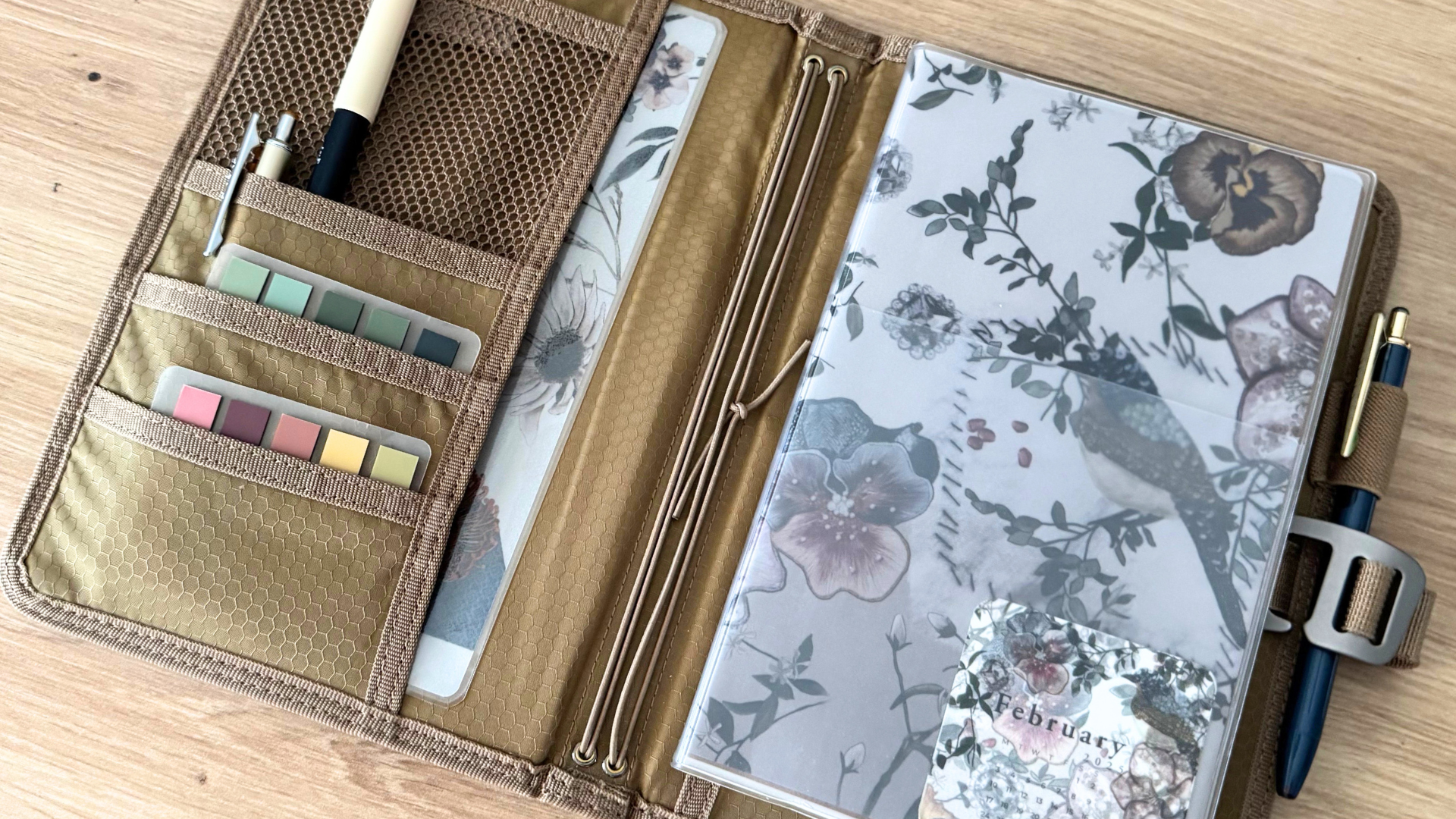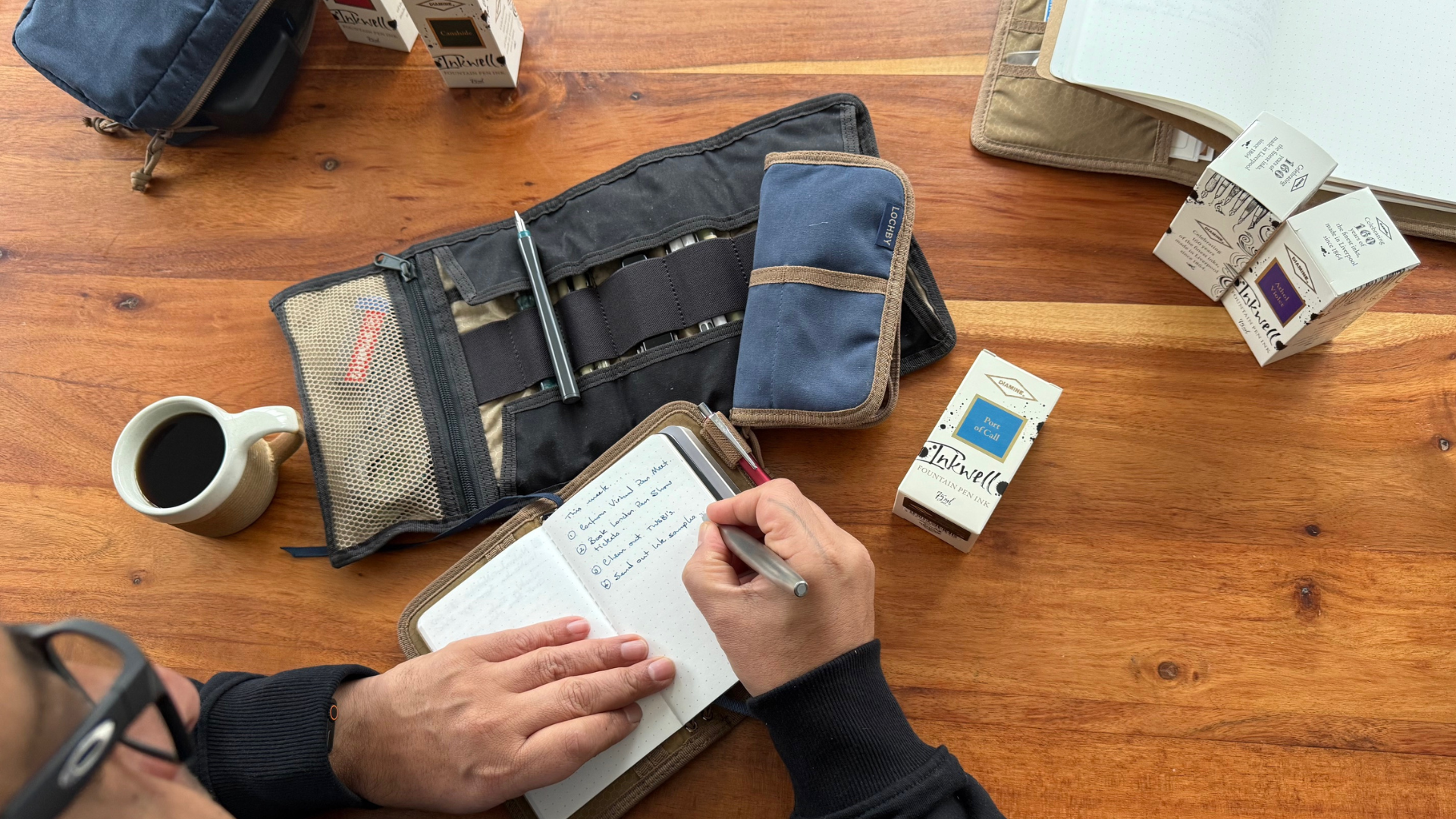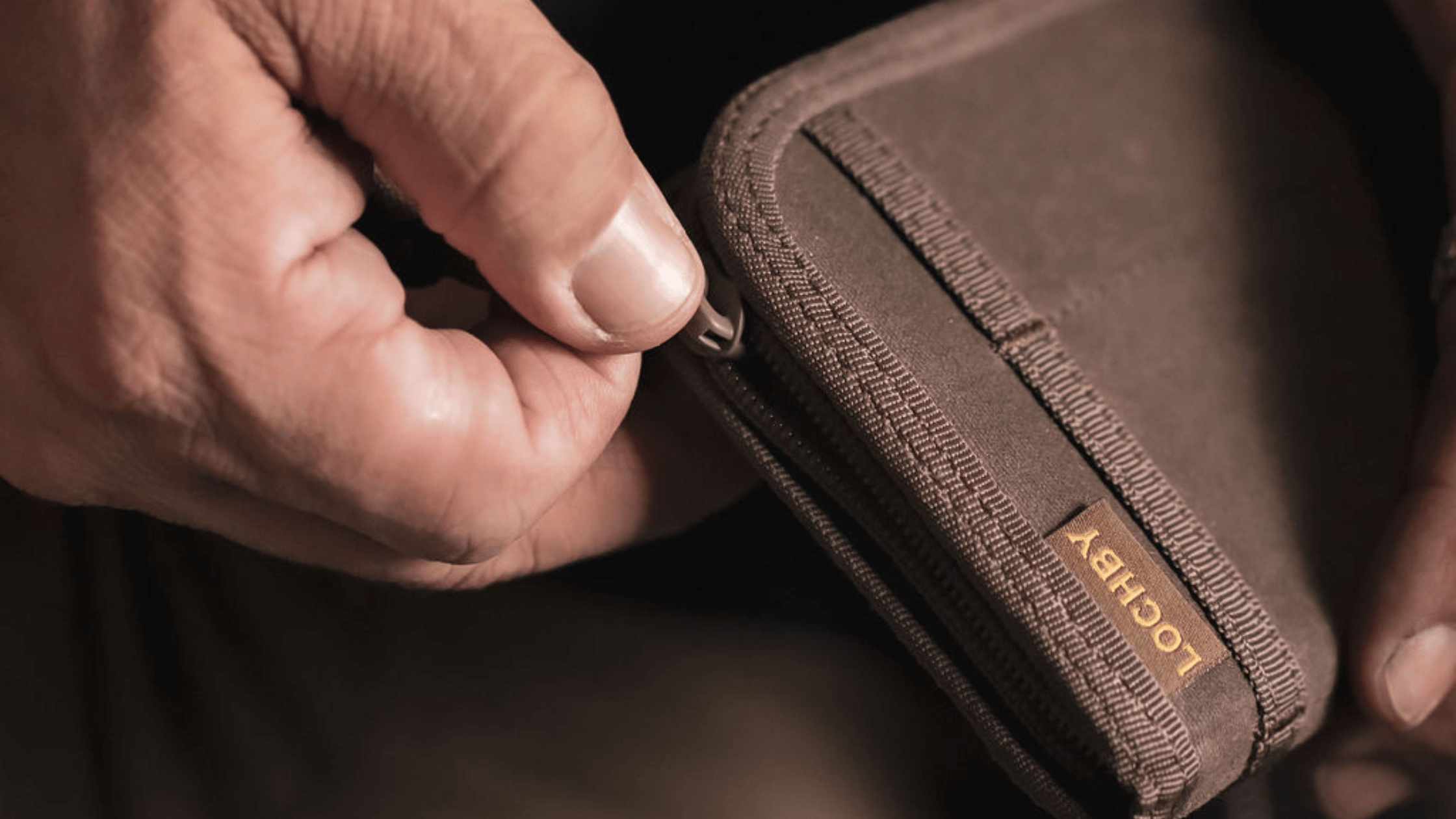If you find your handwriting illegible or not "nice enough," you're not alone. We get a lot of comments that say something similar from different people on social media. But here's the deal: as in all things that we want to change or improve, practice is key. Just take a look at the amazing handwriting journey of our good friend Mike, aka @cursive.not.inkluded and @pencilpality on Instagram. Both accounts display his amazing handwriting skills.
Like we always say here at LOCHBY, it's all about progress, not perfection! Let's hear it from Mike.
Late one night in December of 2016, I stumbled and fell into a bottomless YouTube rabbit hole. I don’t remember what brought me to YouTube in the first place, but I somehow managed to click on a calligraphy tutorial video. I was instantly mesmerized. At the time my handwriting was atrocious, and it had been so long since I had seen cursive, let alone written in cursive myself, that I could barely read what the person was writing. Still, I couldn’t stop watching, one video after another. The following day I decided to give it a try, and while my first attempt was a HUGE failure, I kept on trying and trying.
In early 2017 I created an Instagram account and began sharing my (slow) handwriting progress with the world. Instagram proved instrumental in my early efforts because it provided inspiration from other handwriting accounts and continual encouragement from a supportive community.

Before too long, I moved away from wanting to learn calligraphy and instead set my goal on simply improving my natural, everyday handwriting. It’s now four and a half years later and, while I’m far from a master penman, I’m quite proud of the progress I’ve made.
So, this is me. I’m not an expert and I haven’t been doing this for very long. I’m just a random dude on the internet that rediscovered the joy of writing by hand in the 21st century. Despite this, I’m frequently asked for handwriting advice. This has always caused me some discomfort, because (spoiler alert) I don’t actually know what I’m doing! Nevertheless, having reflected upon my own experience, I’ve written down a few ideas that may be helpful if you’re looking to improve your handwriting.
What follows, however, is not a deep dive into the mechanics of penmanship. I am not going to cover “proper” techniques or grip or posture, etc. Furthermore, if your goal is to learn calligraphy or artistic lettering, the following may not be of much value to you. There are very specific rules and techniques that must be followed in those instances, particularly for calligraphy. Although I appreciate and admire calligraphy, I found out early on that I don’t have the patience to learn it. The suggestions that follow are geared towards those beginners who want to improve their everyday handwriting. While entire books have been written on the subject, I’m going to limit my focus and talk about three interdependent practices that I’m calling the EDCs of handwriting: Exercise, Develop, and Combine.
Exercise
An obvious and universal rule, regardless of your ultimate handwriting goal, is you have to practice. Practice, practice, practice. Honestly, this entire post could have simply read: “If you want to improve your handwriting, you have to practice. The end.” There is no shortcut, no cheat code, no hack, no other option. Hard stop.
More specifically, I suggest you practice as much as possible if you’re just starting out. Handwriting is muscle memory, and if you’re unhappy with the way you write, chances are high that you need to adjust and/or retrain your hand in order to produce different strokes, particularly if you’ve been writing the same way for 20, 30, 40+ years. Don’t expect change to come easily (speaking from experience!).
So, how does one practice?
First, look around for a handwriting style you like so you have a frame of reference and a goal in mind. If available, watch videos so you can see how people move their hand, how they begin and end each stroke – that’s where all the magic happens. From there, you simply copy them. However, your goal should be less about imitating someone else’s handwriting and more about understanding how letters take shape. Take this time to experiment, to break down each stroke of a letter so you understand multiple ways of writing it. My initial focus was on re-learning cursive, but I simultaneously began practicing my print handwriting. I began playing with all kinds of styles, gaining a deeper understanding of how line strokes can be put together, how different styles can be manipulated and combined. So, spend some time engaged in this playful exercise, familiarize yourself with letter forms from all different angles. You’ll begin to develop preferences as you do this and will get a better idea of how you want your handwriting to look.
Once you’re clear about the style you want, practicing becomes a bit more conventional. Now you begin writing out the letters repeatedly and developing your new muscle memory. Whether you do this by filling a whole page with a single letter or writing out “the quick brown fox,” you need to practice as much as possible.

We’re all busy, I don’t expect you to have an extra hour or two in your day to just sit and write nonsense. I didn’t have that luxury when I started, but I stole every spare minute available to me. Literally, I was practicing my letters anywhere and anytime I could. While attending meetings at work, I’d fill up the margins of my agenda; during lunch I’d be eating with one hand and writing with the other; writing grocery or to-do lists became easy opportunities for keeping my hand moving. One minute here, three minutes there, maybe 10 minutes right before bed, it all adds up over time. Just keep a pen and pocket notebook with you and you’ll no doubt find minutes in your day to exercise and strengthen your new muscle memory.
Finally, depending on where you are with your progress, I suggest moving from practicing individual letters to writing out full words as soon as possible. Particularly if you’re developing your cursive, I find that writing out full words and making those connections is a very different experience compared to writing individual letters. In fact, much of the “style” is in the connections, so they are important to practice. This point also applies to printing in my experience. You’ll want to train your hand to shift quickly from one letter to the next. In addition to developing muscle memory for an individual letter, you’ll benefit from developing a memory for writing letters together. Lastly, don’t ignore the blank space. Spacing plays a huge role in the way someone’s handwriting looks, so focus on the blanks and try to be consistent.

Develop
This next point is a bit harder to convey but I think it’s crucial for achieving success with as little frustration as possible. The idea is simple: develop your own handwriting.
Look, you’ve probably heard that a person’s handwriting is as unique as a fingerprint. It’s hard to copy someone’s handwriting, whether the person writes beautifully or not. So, while I’ve suggested that you look around for inspiration and begin a practice routine based on styles you like, I strongly advise against trying to mimic someone’s style completely. Go ahead and be inspired but pay attention to your own natural movements while you’re doing it. Even as you begin retraining your muscle memory, you’ll notice you have default movements and strokes. Pay attention to those so you know what to work on but also so you know what to preserve and nurture. I learned early on that it would be a lot easier to improve my handwriting by accepting some of my natural tendencies and developing a “new and improved” style based on that existing foundation.
You have a handwriting style right now. While you may not be happy with it, you have one, so don’t force yourself to learn how to write from scratch. Take the path of least resistance and work with what you already have. Shape a new style from elements of your natural style. It’s going to be a lot easier to tweak and finesse what you already do than to reinvent the proverbial wheel. This will still take time, effort, and new muscle memory, but a goal of adjustment and fine-tuning is a more viable approach in my opinion. Plus, you get the added benefit of retaining your own unique style.
I am always surprised to receive compliments about my handwriting. I still don’t fully understand why people seem to like what I do. Since it isn’t technically beautiful or perfect, I can only assume it’s because it isn’t technically beautiful or perfect that people are drawn to it.

To the extent that some of my handwriting styles are a bit odd and novel, it’s because I intentionally ignore all style rules. I’m just doing what I want to do, incorporating things that I think look cool. It’s a hodgepodge of natural tendencies (developed over nearly 40 years of mindless writing) and intentional selection of individual elements. So be yourself and have fun. The truth of the matter is we all wish our handwriting looked like somebody else’s. I’m confident there will be someone wishing they could write like you, so make sure it is you.
Combine
The final component of this handwriting EDC deals with maintaining enthusiasm and motivation. In my mind it is both the glue and the grease that holds your practice wheel together and keeps it moving smoothly.
First things first, you must want to improve your handwriting – must be committed to improving for improvement’s sake. That is the obvious prerequisite for success. However, if you’re like me, despite your sincere aspirations, you may find yourself getting discouraged and wanting to give up. To combat this, I urge you to combine your handwriting efforts with allied interests. Here are a few things that I’ve combined with my handwriting practice.
Meditative Markings: Wanting to improve your handwriting will not automatically lead you to enjoy the physical act of writing by hand, but I would encourage you to begin appreciating the almost meditative action of moving pen/pencil over paper. Finding pleasure in the action of writing will certainly contribute to your overall enjoyment. I love taking five minutes to just sit with a blank page and focus on the tactile and sensory experience of writing. I still consider this a practice session, so I remain aware of how I’m writing, but I allow myself a bit more freedom. This is also a great way to practice and get creative. You can freely experiment and develop unique ways of making your letter forms while enjoying the physical experience.
Equip Your Toolbox: You found this post because of your interest in LOCHBY products, so you clearly care about the items you use.
Now, I’m not going to suggest that you need to purchase premium notebooks and pens in order to improve your handwriting. Not at all. Shoot, you can use your freebie bank pen and scraps of paper for all I care. However, just as I encourage you to find joy in the physical act of writing, I urge you to explore different writing instruments and paper so you can experience the different qualities each brings to your handwriting.

I’m a huge pen/pencil/notebook nerd but I only developed an interest in stationery as a means to develop my handwriting. For me, both interests largely developed in tandem and served to reinforce each other. I purchased a fountain pen shortly after watching those YouTube videos back in 2016 and was heartbroken to discover that cursive is not included with the purchase of a fountain pen. So, while I learned that a fountain pen will not magically improve my handwriting, I did fall in love with the experience of writing with a fountain pen nib and I wanted to further explore that feeling. However, I didn’t just fall into the fountain pen rabbit hole, I went crazy trying out everything I could find: Japanese gel pens, premium wood case pencils, mechanical pencils, different size fountain pen nibs and ink (so much ink!), ballpoint pen refills, brush pens, and don’t even get me started on notebooks! I went crazy, like so many of us do, and while I loved collecting and using all these interesting new products, I always framed my mad accumulation within the context of handwriting.
I was searching for and chasing different feelings and sensations. It’s amazing how a particular pen and paper combination can completely change the whole writing experience. So, try things out, nerd out, find the right tool for what you want to do. While I love my fountain pens, I actually prefer writing with a regular old pencil. You don’t need to spend a lot of money either. You can pick up a handful of cool pens and pencils for $10 and see how things feel.
Captain's Log: Find a reason to write independent of your basic practice routine. Consider adopting a journaling/bullet journaling or letter writing habit (yes, pen pals are still a thing). About a year into my “journey,” I looked around at the 100s of notebooks I had acquired and decided I had to do something to make use of all this paper. I started to keep a journal. Let me stress that I never thought I’d ever keep a journal, I’m just “not that guy.” Well, I became that guy and I’ve written between 6 - 8 pages every single day since July 2018. I’ve filled around 100 notebooks so far, mostly pocket notebooks. It was hard to keep it up at first. I wanted to quit after about a month but surprisingly kept with it. Now I can’t imagine skipping a day.
I don’t consider writing a journal entry as handwriting practice per se, but it is of course practice, or better said, it is my handwriting in practice. If like me you’re not a journal person, or at least don’t think you are, consider taking up letter writing. You can easily find willing pen pals from among the stationery community, or you can even send a letter to me. Just know upfront that I won’t respond, because I’m not a letter writing person.
There are a lot of things you can incorporate as supplemental writing exercises. Some people like transcribing novels or bible passages. It doesn’t matter what you choose, but I do suggest finding a complementary interest or hobby to help you stay excited about writing every day, because writing out the alphabet and pangrams will get old real fast.
Join the Club: I noted at the beginning that Instagram was crucial to my early handwriting progress. I know, I know, Instagram and social media in general are rife with problems and can quickly grow into an unhealthy habit. But like anything, used in moderation it can be very beneficial, particularly in this instance. Having access to a like-minded community of people to inspire you and cheer you on is invaluable. At the very least you know you’re not alone.

Look, I am the king of introverts and I managed to will myself to open an account and join the club, so if you’re nervous about putting yourself out there, don’t be. The stationery community is (mostly) welcoming and supportive. Besides, you can do it anonymously if you want, so you have nothing to lose. Community support, whether through Instagram, a Facebook group, or an online forum, can make a world of difference in keeping you interested, engaged, and motivated to keep practicing. Posting your handwriting pictures on Instagram also adds a degree of accountability and gives you a nice historical record to track your progress over time.
These are the things I did to supplement and enhance my interest in improving my handwriting. If these don’t appeal to you, I encourage you to find something that does. You don’t want your handwriting practice to feel like a chore, so let it dissolve seamlessly into another activity, allow it to become associated with something else positive in your life.

To sum things up: improving your handwriting will take time and, if you’re anything like me, you’ll likely get frustrated and discouraged along the way, but keep practicing, keep trying, keep experimenting and exercising to build new muscle memory. Look around for inspiration, borrow and adapt different ideas, but ultimately develop your own unique handwriting style based around your natural tendencies as much as possible. Finally, find ways to stay motivated by combining your practice with adjacent interests so that all your effort disappears into compounded amusement.
Make your handwriting a part of your EDC, keep it maintained and ready to use at all times. Write often and write hard!





Share:
4 Great Alternatives to Work-Life Balance
5 Ways Journaling Can Boost Your Creativity